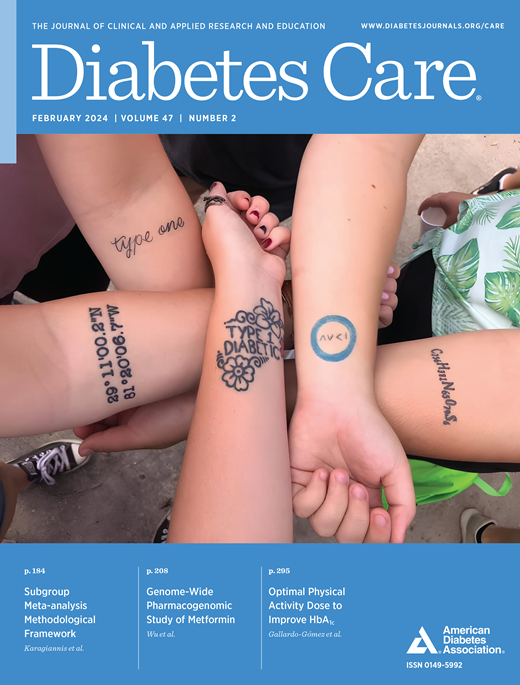Diabetes-Related Distress and Glycemic Dysregulation in Everyday Life With Type 1 Diabetes: Which Comes First?
IF 16.6
1区 医学
Q1 ENDOCRINOLOGY & METABOLISM
引用次数: 0
Abstract
OBJECTIVE In an observational study, we paired ecological momentary assessment (EMA) and continuous glucose monitoring (CGM) to examine lagged effects of glycemic regulation on diabetes-related distress (DD), and vice versa, among adults with type 1 diabetes (T1D). RESEARCH DESIGN AND METHODS Participants (N = 182; median ± SD age 40 ± 14 years; 54% women; 41% Latino; 29% White and 15% Black) wore a blinded CGM device for 14 days and completed five to six EMA surveys per day. We tested expected associations between momentary DD ratings and relevant patient-reported outcomes on validated questionnaires. Using multilevel cross-lagged modeling, we evaluated within-person lagged effects of CGM metrics (mean glucose mean; percentage of time in range [TIR; i.e., 70–180 mg/dL] and percentages of time 181–250, >250, and <70 mg/dL; and coefficient of variation [CV]) over 3-h periods on DD rated 0–100 at the end of that interval and 3 h later. We also examined lagged effects of DD on subsequent CGM metrics. RESULTS Momentary DD ratings were significantly associated with results of questionnaires for DD, well-being, functional and mental health, and quality of life. Higher mean glucose, less TIR, greater percentage of time 181–250 and >250 mg/dL, and higher CV over 3 h each predicted greater DD at the end of that interval; higher 3-h mean glucose also predicted more DD 3 h later (P < 0.05). Greater DD unexpectedly predicted a lower percentage of time in hypoglycemia over the next 3 h (P < 0.05) but predicted no other CGM metrics. CONCLUSIONS Findings support the validity of EMA of DD in adults with T1D and suggest glucose dysregulation is linked to subsequent increased DD over the short term, not vice versa. These findings have implications for interventions targeting DD.1型糖尿病患者日常生活中与糖尿病相关的痛苦和血糖失调:孰先孰后?
目的:在一项观察性研究中,我们将生态瞬时评估(EMA)和连续血糖监测(CGM)配对,以研究血糖调节对1型糖尿病(T1D)患者糖尿病相关窘迫(DD)的滞后效应,反之亦然。研究设计与方法参与者(N = 182;中位±SD年龄40±14岁;54%的女性;41%的拉丁裔;29%白人和15%黑人)佩戴盲法CGM设备14天,每天完成5至6次EMA调查。我们在有效问卷上测试了瞬时DD评分与相关患者报告结果之间的预期关联。使用多层交叉滞后模型,我们评估了CGM指标(平均葡萄糖平均值;范围内时间百分比[TIR;(即70 - 180mg /dL)和181-250、&;gt;250和&;lt; 70mg /dL的时间百分比;和变异系数[CV])在3 h周期内,在该间隔结束时和3 h后,DD评分为0-100。我们还检查了DD对后续CGM指标的滞后影响。结果瞬时DD评分与DD、幸福感、功能和心理健康以及生活质量问卷结果显著相关。较高的平均葡萄糖,较低的TIR,较大的时间百分比181-250和&;gt;250 mg/dL,以及较高的CV超过3小时,都预示着该间隔结束时DD的增加;较高的3小时平均血糖也预示着3小时后DD的增加(P <;0.05)。更大的DD出人意料地预示着在接下来的3小时内低血糖的时间百分比更低(P <;0.05),但没有预测其他CGM指标。结论:研究结果支持成年T1D患者DD的EMA的有效性,并提示短期内葡萄糖失调与随后的DD增加有关,而不是相反。这些发现对针对DD的干预措施具有启示意义。
本文章由计算机程序翻译,如有差异,请以英文原文为准。
求助全文
约1分钟内获得全文
求助全文
来源期刊

Diabetes Care
医学-内分泌学与代谢
CiteScore
27.80
自引率
4.90%
发文量
449
审稿时长
1 months
期刊介绍:
The journal's overarching mission can be captured by the simple word "Care," reflecting its commitment to enhancing patient well-being. Diabetes Care aims to support better patient care by addressing the comprehensive needs of healthcare professionals dedicated to managing diabetes.
Diabetes Care serves as a valuable resource for healthcare practitioners, aiming to advance knowledge, foster research, and improve diabetes management. The journal publishes original research across various categories, including Clinical Care, Education, Nutrition, Psychosocial Research, Epidemiology, Health Services Research, Emerging Treatments and Technologies, Pathophysiology, Complications, and Cardiovascular and Metabolic Risk. Additionally, Diabetes Care features ADA statements, consensus reports, review articles, letters to the editor, and health/medical news, appealing to a diverse audience of physicians, researchers, psychologists, educators, and other healthcare professionals.
 求助内容:
求助内容: 应助结果提醒方式:
应助结果提醒方式:


